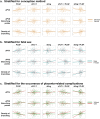Maternal serum PlGF associates with 3D power doppler ultrasound markers of utero-placental vascular development in the first trimester: the rotterdam periconception cohort
- PMID: 39143350
- PMCID: PMC11564232
- DOI: 10.1007/s10456-024-09939-3
Maternal serum PlGF associates with 3D power doppler ultrasound markers of utero-placental vascular development in the first trimester: the rotterdam periconception cohort
Abstract
Objective (s): Circulating angiogenic factors are used for prediction of placenta-related complications, but their associations with first-trimester placental development is unknown. This study investigates associations between maternal angiogenic factors and utero-placental vascular volume (uPVV) and utero-placental vascular skeleton (uPVS) as novel imaging markers of volumetric and morphologic (branching) development of the first-trimester utero-placental vasculature.
Methods: In 185 ongoing pregnancies from the VIRTUAL Placenta study, a subcohort of the ongoing prospective Rotterdam Periconception cohort, three-dimensional power Doppler ultrasounds of the placenta were obtained at 7-9-11 weeks gestational age (GA). The uPVV was measured as a parameter of volumetric development and reported the vascular quantity in cm3. The uPVS was generated as a parameter of morphologic (branching) development and reported the number of end-, bifurcation- crossing- or vessel points and total vascular length. At 11 weeks GA, maternal serum biomarkers suggested to reflect placental (vascular) development were assessed: placental growth factor (PlGF), soluble fms-like tyrosine kinase-1 (sFlt-1) and soluble endoglin (sEng). sFlt-1/PlGF and sEng/PlGF ratios were calculated. Multivariable linear regression with adjustments was used to estimate associations between serum biomarkers and uPVV and uPVS trajectories.
Results: Serum PlGF was positively associated with uPVV and uPVS development (uPVV: β = 0.39, 95% CI = 0.15;0.64; bifurcation points: β = 4.64, 95% CI = 0.04;9.25; crossing points: β = 4.01, 95% CI = 0.65;7.37; total vascular length: β = 13.33, 95% CI = 3.09;23.58, all p-values < 0.05). sEng/PlGF ratio was negatively associated with uPVV and uPVS development. We observed no associations between sFlt-1, sEng or sFlt-1/PlGF ratio and uPVV and uPVS development.
Conclusion(s): Higher first-trimester maternal serum PlGF concentration is associated with increased first-trimester utero-placental vascular development as reflected by uPVV and uPVS. Clinical trial registration number Dutch Trial Register NTR6854.
Keywords: Angiogenesis; Angiogenic factors; Placenta; Preeclampsia; Spiral artery remodeling; sFlt-1.
© 2024. The Author(s).
Conflict of interest statement
Figures




Similar articles
-
Morphologic development of the first-trimester utero-placental vasculature is positively associated with embryonic and fetal growth: the Rotterdam Periconception Cohort.Hum Reprod. 2024 May 2;39(5):923-935. doi: 10.1093/humrep/deae056. Hum Reprod. 2024. PMID: 38503486 Free PMC article.
-
First-trimester 3D power Doppler imaging markers of utero-placental vascular development are associated with placental weight and diameter at birth: The Rotterdam Periconception Cohort.Placenta. 2024 Mar 25;148:44-52. doi: 10.1016/j.placenta.2024.01.019. Epub 2024 Feb 8. Placenta. 2024. PMID: 38367314
-
Assessment of first-trimester utero-placental vascular morphology by 3D power Doppler ultrasound image analysis using a skeletonization algorithm: the Rotterdam Periconception Cohort.Hum Reprod. 2022 Oct 31;37(11):2532-2545. doi: 10.1093/humrep/deac202. Hum Reprod. 2022. PMID: 36125007 Free PMC article.
-
Combining Biomarkers to Predict Pregnancy Complications and Redefine Preeclampsia: The Angiogenic-Placental Syndrome.Hypertension. 2020 Apr;75(4):918-926. doi: 10.1161/HYPERTENSIONAHA.119.13763. Epub 2020 Feb 17. Hypertension. 2020. PMID: 32063058 Free PMC article. Review.
-
First trimester mechanisms of gestational sac placental and foetal teratogenicity: a framework for birth cohort studies.Hum Reprod Update. 2021 Jun 22;27(4):747-770. doi: 10.1093/humupd/dmaa063. Hum Reprod Update. 2021. PMID: 33675653 Free PMC article. Review.
References
-
- Junaid TO et al (2014) Fetoplacental vascular alterations associated with fetal growth restriction. Placenta 35(10):808–815. 10.1016/j.placenta.2014.07.013 - PubMed
-
- Sato Y (2020) Endovascular trophoblast and spiral artery remodeling. Mol Cell Endocrinol 503:110699. 10.1016/j.mce.2019.110699 - PubMed
Publication types
MeSH terms
Substances
LinkOut - more resources
Full Text Sources
Miscellaneous

